Securing your garage door is critical for the overall safety of your home. As a point of entry often overlooked, an unsecured garage door can be a significant vulnerability, offering easy access to potential intruders.

Roll-up garage doors, while convenient and space-saving, can be particularly susceptible to forced entry if not properly locked. Common weaknesses include flimsy materials and inadequate locking mechanisms.
Understanding how to lock a roll up garage door effectively is paramount to ensuring your home’s security.
There are various methods to enhance the security of a roll-up garage door, ranging from traditional locks like slide bolts and padlocks to advanced keyless locking systems. Taking the necessary steps to secure your garage door will help protect your home and provide peace of mind.
Understanding the Types of Roll-Up Garage Doors
Roll-up garage doors come in two primary types: manual and automatic. Manual roll-up garage doors require physical effort to open and close, making them a straightforward option for homeowners who prefer simplicity and reliability.
On the other hand, automatic roll-up garage doors are operated by a remote control or a wall-mounted switch, offering enhanced convenience and ease of use, particularly for those with limited mobility or busy lifestyles. Both types can be found in various materials, each presenting unique benefits.
Steel is a popular choice for roll-up garage doors due to its durability and strength, providing a high level of security.
Aluminum is another common material, favored for its lightweight nature and resistance to rust and corrosion, making it ideal for coastal areas.
Wooden roll-up garage doors, while offering a classic and aesthetically pleasing look, require more maintenance to withstand weather elements and can be slightly less secure than metal options.
Common locking mechanisms found on roll-up garage doors include slide bolts, which manually secure the door from the inside, and padlocks with hasps that provide an effective external locking solution.
For automatic doors, built-in security features like electronic keypads or combination locks offer keyless entry and added convenience. Understanding these options helps homeowners choose the best method to secure their roll-up garage doors effectively.
Tools and Materials Needed
- List of Tools: drill, screwdriver, wrench, measuring tape, pencil
- List of Materials: lock mechanism (slide bolt, padlock, keyless lock), mounting hardware
- Optional: lubricant for smooth operation of the lock
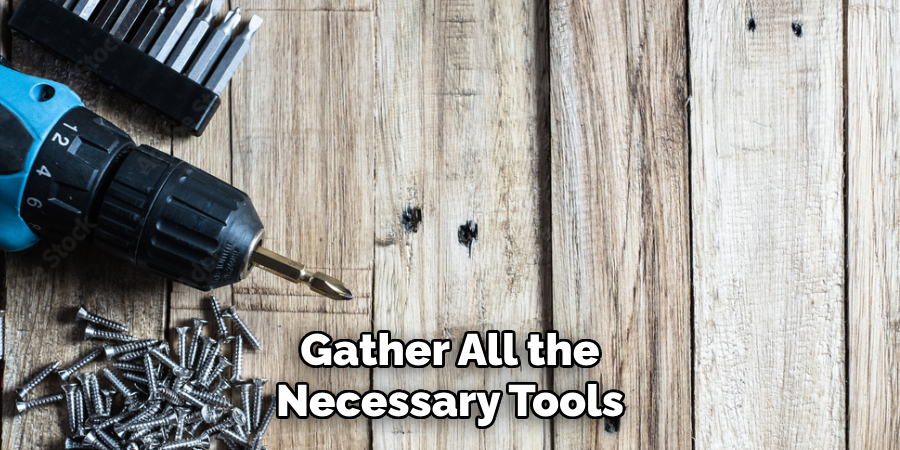
How to Lock a Roll up Garage Door: Installing a Slide Bolt Lock
Installing a slide bolt lock on your roll-up garage door is a practical and straightforward way to enhance security. Follow this step-by-step guide to ensure a secure and smooth installation:
Measuring and Marking the Position for The Slide Bolt:
Start by deciding where you want to place the slide bolt on the garage door. It is usually installed on the inside, near the bottom or top edge of the door. Use a measuring tape to pinpoint the exact location.
Once measured, use a pencil to mark the points where the slide bolt and its catch will be mounted.
Drilling Pilot Holes for The Screws:
Next, take a drill with the appropriate bit size for the screws provided with the slide bolt lock. Drill pilot holes at the marked points on both the garage door and the frame if necessary. These pilot holes will guide the screws during installation and ensure that the wood or metal does not split.
Securing the Slide Bolt to The Garage Door Frame:
Place the slide bolt over the pilot holes on the garage door. Make sure the bolt aligns correctly with its catch on the frame.
Using a screwdriver or a power drill with a screwdriver bit, screw the slide bolt into place. Ensure that all screws are tightly secured to keep the slide bolt firmly in position.
Testing the Slide Bolt for Smooth Operation and Secure Locking:
Finally, test the slide bolt by sliding it back and forth several times to ensure it operates smoothly. Lock and unlock it multiple times to check for any resistance or difficulty. If needed, apply a small amount of lubricant to the moving parts to maintain smooth operation.
By following these steps, you can effectively install a slide bolt lock on your roll-up garage door, enhancing both security and functionality.
How to Lock a Roll up Garage Door: Using a Padlock and Hasps
Securing your roll-up garage door with a padlock and hasps is an effective way to enhance its security. Here is a step-by-step guide to help you through the installation process:
Choosing a Durable and Weather-Resistant Padlock:
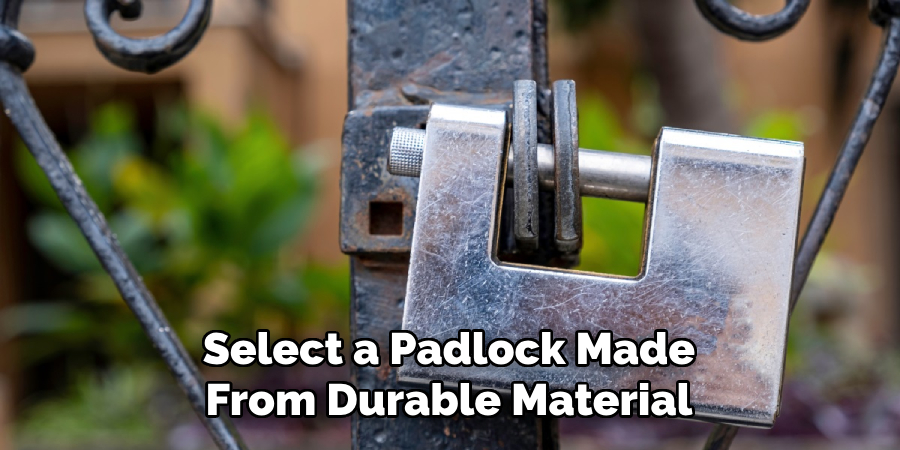
Begin by selecting a padlock made from durable, weather-resistant stainless steel or brass materials. These materials will withstand harsh environmental conditions, providing long-lasting security.
Installing Hasps on The Garage Door and Frame:
Hasps consists of two parts: one part attaches to the movable door, while the other attaches to the garage’s fixed frame.
Measuring and Marking the Position for The Hasps:
Decide on the optimal location for installing the hasps, usually towards the bottom or middle of the door. Use a measuring tape to ensure that both parts align properly when the door is closed. Mark the positions with a pencil.
Drilling Pilot Holes and Securing the Hasps with Screws:
Use a drill with an appropriate bit size to create pilot holes at the marked points on both the door and the frame.
This will guide the screws and prevent splitting of the material. Once the pilot holes are drilled, secure both parts of the hasps with screws, ensuring they are tightly fitted and properly aligned.
Attaching the Padlock to The Hasps and Securing It:
With the hasps securely installed, close the garage door and slip the padlock’s shackle through the aligned loops of the hasps. Lock the padlock and double-check the installation to ensure that it functions correctly and provides a snug fit.
By following these steps, you can effectively use a padlock and hasps to add an extra layer of security to your roll-up garage door.
Implementing a Keyless Locking System
Advantages of keyless locks:
Keyless locks offer significant convenience. They eliminate the need for physical keys, reducing the risk of losing them or leaving them behind. They also allow for quick and easy access, often using a simple code or electronic access method.
This added convenience is particularly beneficial for families or individuals with varying schedules, as it provides flexible and secure access without the hassle of duplicating keys.
Types of keyless locks:
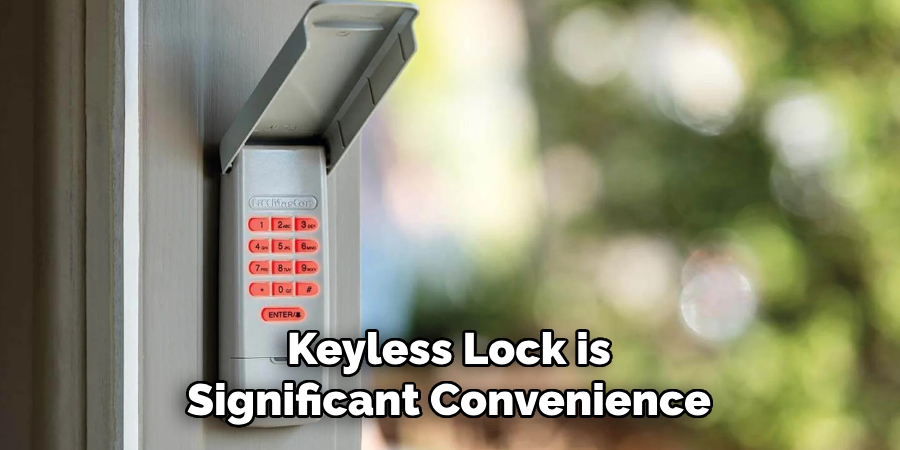
Keyless locks come in various forms, including combination locks and electronic keypads. Combination locks use a set code of numbers that, when correctly entered, unlock the door.
Electronic keypads offer more advanced features, such as backlit numbers for low-light visibility and the ability to change codes easily when needed.
Step-By-Step Guide to Installing a Keyless Lock:
Measuring and marking the position for the lock:
Start by deciding where to install the keyless lock on the garage door. Typically, it is placed at a convenient height for easy access. Use a measuring tape to mark the exact position where the lock mechanism will be mounted.
Drilling holes and securing the lock mechanism:
Using the appropriate drill bit size for the screws provided with your keyless lock, drill holes at the marked points.
Carefully align the lock mechanism with the drilled holes and secure it to the garage door using the screws. Ensure that the lock is tightly fitted to avoid any looseness that could compromise security.
Programming the keyless lock with a secure code:
After securing the lock mechanism, follow the manufacturer’s instructions to program the lock with a secure code.
Choose a code that is easy for you to remember but difficult for others to guess. For added security, consider periodically changing the code.
Testing the keyless lock for functionality and security:
Finally, test the keyless lock by entering the programmed code to ensure it unlocks and locks without any issues. Perform several tests to confirm that the lock functions smoothly and securely.
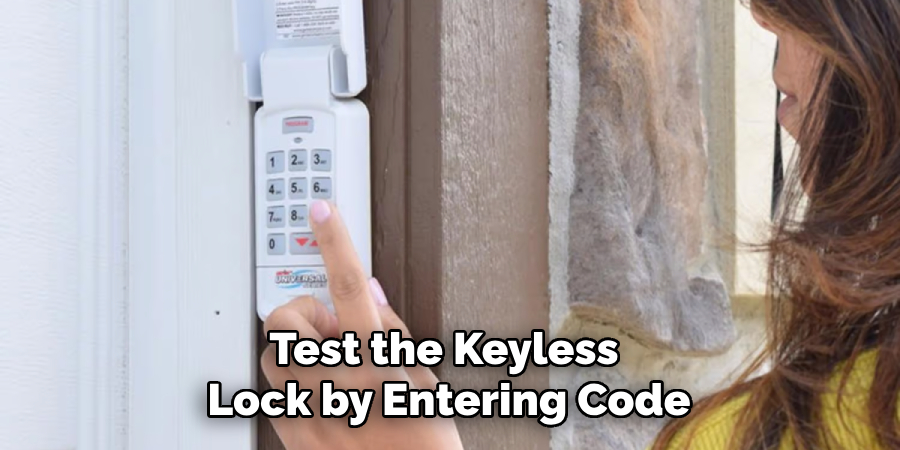
Adding Extra Security Measures
By following these steps, you can successfully install a keyless locking system on your roll-up garage door, enhancing its security and convenience.
Installing a Garage Door Defender:
1.Positioning the defender in front of the garage door:
To install a garage door defender, place it directly in front of your roll-up garage door. The defender should be positioned centrally and close enough to the door to restrict any potential forced entry.
2.Securing the defender to the ground with bolts:
Mark the positions where the securing bolts will be drilled into the ground. Use a drill with an appropriate bit to create the necessary holes. Insert the bolts, ensuring they penetrate the surface deeply for maximum hold. Tighten the bolts to secure the defender firmly to the ground, ensuring no movement.
Using a Garage Door Security Bar:
1.Placing the security bar across the garage door:
A garage door security bar is another effective measure to enhance the security of your garage. Position the bar horizontally across the interior side of the garage door at a level that prevents it from being lifted.
2.Adjusting the bar to fit snugly and securely:
Adjust the security bar’s length to fit your garage door width, ensuring it spans the door completely. Once properly adjusted, secure the bar by attaching it to either side of the garage walls or door frame with the provided brackets.
These brackets should be tightly fastened to prevent any wobbling or displacement of the security bar. Incorporating these additional security measures can further fortify your roll-up garage door against unauthorized access.
Regular Maintenance and Security Checks
Importance of Regularly Checking and Maintaining the Locking Mechanisms:
Regularly inspecting and maintaining the locking mechanisms of your garage door is essential for ensuring long-term security and functionality. Routine checks help identify any signs of wear, tampering, or potential weaknesses that could compromise the security of your garage.
Lubricating Locks and Moving Parts to Ensure Smooth Operation:
Maintaining the smooth operation of locks and moving parts involves periodic lubrication. Apply a high-quality lubricant to all moving components, including the locks, hinges, and rollers. This reduces friction, prevents rust, and enhances the longevity of the locking mechanisms.
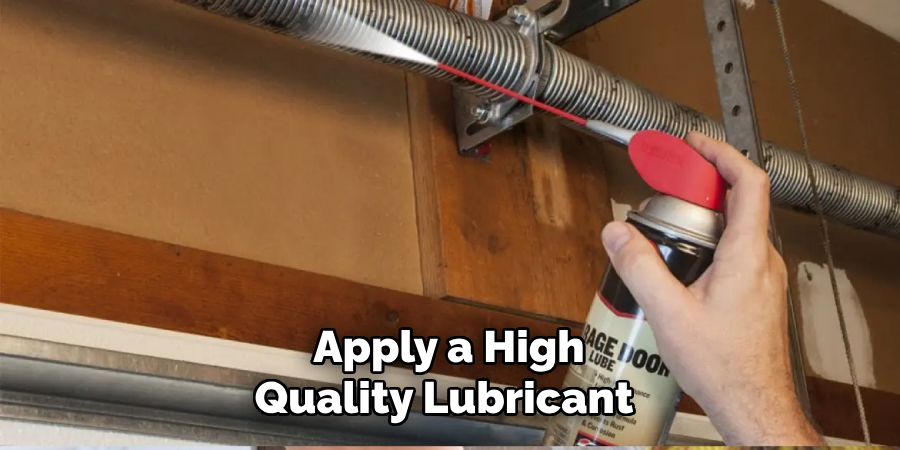
Inspecting for Signs of Wear or Tampering and Addressing Issues Promptly:
During inspections, look for signs of damage, wear, or tampering. If you notice any issues, such as bent components, loose screws, or scratch marks around the lock, address them immediately.
Tighten any loose parts, replace damaged components, and reset any tampered locks to restore full security to your roll-up garage door. Regular maintenance ensures optimal performance and protection against unauthorized access.
Conclusion
Securing a roll-up garage door is crucial to safeguarding your home and its contents. By understanding how to lock a roll up garage door effectively, you enhance not only security but also peace of mind.
Regular maintenance and routine locking mechanism checks ensure they remain functional and reliable over time. Keeping everything well-lubricated and promptly addressing any signs of wear or tampering can prevent potential breaches.
Ultimately, a well-secured garage door acts as a solid barrier against unauthorized access, contributing to the overall security of your home. Prioritizing these steps will help you maintain a secure environment for your family, ensuring that your home remains a safe haven.
About
Safety Fic is a distinguished figure in the world of Diy design, with a decade of expertise creating innovative and sustainable Diy solutions. His professional focus lies in merging traditional craftsmanship with modern manufacturing techniques, fostering designs that are both practical and environmentally conscious. As the author of diy, Safety Fic delves into the art and science of Safety Fic-making, inspiring artisans and industry professionals alike.
Education RMIT University
(Melbourne, Australia) Associate Degree in Design (Safety Fic) Focus on sustainable design, industry-driven projects, and practical craftsmanship. Gained hands-on experience with traditional and digital manufacturing tools, such as CAD and CNC software.
Nottingham Trent University
(United Kingdom) Bachelor’s in diyfastly.com and Product Design (Honors) Specialized in product design with a focus on blending creativity with production techniques. Participated in industry projects, working with companies like John Lewis and Vitsoe to gain real-world insights.
Publications and Impact
In diy, Safety Fic his insights on indoor design processes, materials, and strategies for efficient production. His writing bridges the gap between artisan knowledge and modern industry needs, making it a must-read for both budding designers and seasoned professionals.
